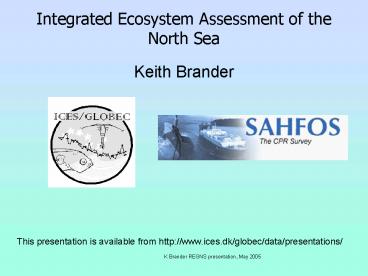Integrated Ecosystem Assessment of the North Sea - PowerPoint PPT Presentation
1 / 22
Title:
Integrated Ecosystem Assessment of the North Sea
Description:
This presentation is available from http://www.ices.dk/globec ... K Brander REGNS presentation, May 2005. We do not need to ... REGNS presentation, May ... – PowerPoint PPT presentation
Number of Views:30
Avg rating:3.0/5.0
Title: Integrated Ecosystem Assessment of the North Sea
1
Integrated Ecosystem Assessment of the North Sea
- Keith Brander
This presentation is available from
http//www.ices.dk/globec/data/presentations/
2
- We do not need to reinvent the wheel(but we
might want to improve it a bit)
3
(No Transcript)
4
Metric used in this study
Biotic metrics
Abiotic metrics
Human metrics
5
(No Transcript)
6
- approach combines empirical, reductionist and
holistic methods - based on the integrated analysis of 55 primary
and secondary biotic, abiotic, and human
variables over a 43 year period - integrated analysis shows that the ESS ecosystem
has changed states from a community dominated by
large-bodied demersal fish to one dominated by
small demersal and pelagic fish species and
benthic macro-invertebrates.
7
- dynamic inter-play between ocean physics, biology
and exploitation presents a more realistic causal
scenario than any single component hypothesis,
such as fishing pressure alone. - forces contributing to the stability of the
alternate state include both top-down processes
involving strong trophic interactions initiated
at the apex predator level and bottom-up
processes involving energy flow and nutrient
cycling that have fundamentally altered the
matter and energy flow patterns in the ESS
ecosystem - higher-order variables are identified as early
warning indicators, sensitive to the underlying
structural and functional changes - they have been determined for an adjacent system
where systemic changes have not yet been observed
and predict a potential collapse within a decade. - integrated assessment of ecosystems is a great
challenge and their management requires
comprehension of ecological systems.
8
- description alone is not sufficient to allow
comprehension, especially if information
overload (the disconnect between system
description and system comprehension) is to be
avoided and meaningful insights and strategies
are to emerge. - reductionistic analysis involves the dissection
and identification of key processes or feedback
mechanisms likely to be operative in an
ecological system. - however, value cannot be ascertained from
variations in processes, as a directionality of
time does not exist in such a perspective. In
fact, the approach has accelerated the
information overload experienced by all
stakeholders. - holistic approaches are being increasingly used
to aid in the valuation of ecological systems as
the directionality of time is made explicit in
this perspective. - we suggest that integrated assessment requires
not only the integration of descriptive
information, but also the integration of our
perception of ecological systems as being both a
whole and a part.
9
An Integrated Assessment will
- Go beyond Status Reporting
- Evaluate current drivers and how they have shaped
the present state - Identify important interactions between
components of the system and how these affect
system behaviour - Evaluate wider consequences (performance) of
management actions - Predict consequences of
- non-controllable factors such as climate change
- controllable factors
10
Terms of Reference are to
- Hold a workshop to produce a preliminary proof
of concept integrated ecosystem assessment for
the North Sea. - Compile and synthesise material from the twenty
identified source Working Groups, which have
been requested to provide data, information and
indicators - Produce summary presentations of the material as
an overview (e.g., using methods for re-scaling
and reducing dimensionality traffic lights,
etc.) - Identify gaps in the material provided and the
subjects covered - Review patterns and interactions among the
indicators. Preliminary description of system
behaviour (e.g., evidence for regime shift in
late 1980s) and strength of attribution of causes
of observed changes - Comment on how to measure impacts of past
management actions at the system level
11
North Sea data available for REGNS
12
Standardised anomalies of CPR, oceanographic and
fisheries data for the North Sea sorted on first
axis of variation
13
The abrupt change in the North Sea in 1987-88 has
been described as a regime shift(Beaugrand
(2004) The North Sea regime shift evidence,
causes, mechanisms and consequences. Progress in
Oceanography 60 245-262)
This and the previous graph were produced by Jae
Choi DFO, Canada
14
Scottish RV trawl catches since 1925(55-61oN
4oE-4oW) Beare et al. ICES CM 2003/Q24
15
(No Transcript)
16
Terms of Reference are to
- Hold a workshop to produce a preliminary proof
of concept integrated ecosystem assessment for
the North Sea. - Compile and synthesise material from the twenty
identified source Working Groups, which have
been requested to provide data, information and
indicators - Produce summary presentations of the material as
an overview (e.g., using methods for re-scaling
and reducing dimensionality traffic lights,
etc.) - Identify gaps in the material provided and the
subjects covered - Review patterns and interactions among the
indicators. Preliminary description of system
behaviour (e.g., evidence for regime shift in
late 1980s) and strength of attribution of causes
of observed changes - Comment on how to measure impacts of past
management actions at the system level
17
Changes in plankton, fish distribution and
production
- (this is from a short review prepared by KB for
the fourth IPCC Assessment based on papers
published in Nature (2) Science (2) and elsewhere
since 2003) - The principal climate indicator for the N
Atlantic, the NAO, has been rising over the past
30 years and the surface waters of the North
Atlantic have been warming. This has caused
extensive changes in the planktonic ecosystem.
Although the precise mechanisms are not fully
understood, we can detect consequences for
plankton production, biodiversity, species
distribution, and fisheries production.
18
High NAO brings strong, warm westerly winter
winds.This projection of future NAO state is
bad news for N Sea cod!
The relative confidence level for this simulation
is low http//www.ukcip.org.uk/resources/publicati
ons/documents/14.pdf
19
(No Transcript)
20
(No Transcript)
21
(No Transcript)
22
(No Transcript)






























